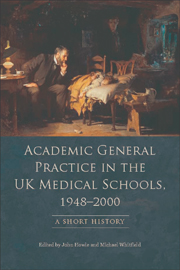Book contents
- Frontmatter
- Contents
- Preface
- Acknowledgements
- Abbreviations
- Timeline
- Introduction
- Dedication
- 1 The University of Aberdeen
- 2 The University of Dundee
- 3 The University of Edinburgh
- 4 The University of Glasgow
- 5 The Cardiff University School of Medicine
- 6 Academic General Practice in Ireland
- 7 The University of Birmingham
- 8 The University of Bristol
- 9 The University of Cambridge
- 10 The University of Exeter
- 11 The University of Leeds
- 12 The University of Leicester
- 13 The University of Liverpool
- 14 The University of Manchester
- 15 The University of Newcastle
- 16 The University of Nottingham
- 17 The University of Oxford
- 18 The University of Sheffield
- 19 The University of Southampton
- 20 The London Medical Schools
- 21 The University of St Andrews
- Appendix 1 Primary Care in the New Medical Schools
- Appendix 2 The SIFT/ACT Negotiations
- Appendix 3 An Overview
- Appendix 4 And Finally…
- Index
12 - The University of Leicester
Published online by Cambridge University Press: 05 August 2013
- Frontmatter
- Contents
- Preface
- Acknowledgements
- Abbreviations
- Timeline
- Introduction
- Dedication
- 1 The University of Aberdeen
- 2 The University of Dundee
- 3 The University of Edinburgh
- 4 The University of Glasgow
- 5 The Cardiff University School of Medicine
- 6 Academic General Practice in Ireland
- 7 The University of Birmingham
- 8 The University of Bristol
- 9 The University of Cambridge
- 10 The University of Exeter
- 11 The University of Leeds
- 12 The University of Leicester
- 13 The University of Liverpool
- 14 The University of Manchester
- 15 The University of Newcastle
- 16 The University of Nottingham
- 17 The University of Oxford
- 18 The University of Sheffield
- 19 The University of Southampton
- 20 The London Medical Schools
- 21 The University of St Andrews
- Appendix 1 Primary Care in the New Medical Schools
- Appendix 2 The SIFT/ACT Negotiations
- Appendix 3 An Overview
- Appendix 4 And Finally…
- Index
Summary
Leicester was the last of the three new medical schools to be established in the twentieth century after Southampton and Nottingham. It accepted its first medical students in 1975. General practice was initially contained within the department of community health functioning as a semi-autonomous unit alongside epidemiology and biostatistics.
Originally housed on the Leicester Royal Infirmary site, the unit moved to purpose-adapted premises at the Leicester General Hospital in 1992, shortly after becoming an independent department of general practice as a consequence of its widening activities and substantial increase in personnel. In 1995, reflecting its expansion beyond the boundaries of general medical practice, its title was altered to the department of general practice and primary health care. In 2003, following a major reorganisation of the entire medical school into five research departments, the department became the division of general practice and primary health care within the department of health sciences. Staff primarily involved with teaching were transferred to the department of medical and social care education.
The original academic staff consisted of a professor (Marshall Marinker, who left in 1982 to head the MSD Foundation) and five part-time lecturers all on three sessions per week. Four of these went on to more senior positions, namely Robin Fraser (who became a full-time senior lecturer in 1980 and was professor of general practice from 1984–2004), Judith Millac and Henry Patterson (both future regional advisers), and Elan Preston-Whyte (who became a senior lecturer).
- Type
- Chapter
- Information
- Academic General Practice in the UK Medical Schools, 1948-2000A Short History, pp. 58 - 60Publisher: Edinburgh University PressPrint publication year: 2011



